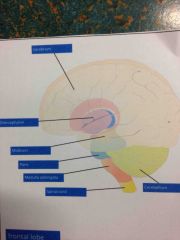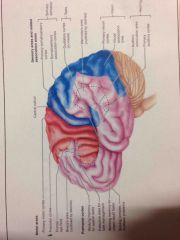![]()
![]()
![]()
Use LEFT and RIGHT arrow keys to navigate between flashcards;
Use UP and DOWN arrow keys to flip the card;
H to show hint;
A reads text to speech;
12 Cards in this Set
- Front
- Back
|
What is the difference between white and grey matter |
White is regions of the brain and spinal cord containing dense collection of myelinated fibers Grey is nerve cell bodies and nonmyelinated fibers |
|
|
What is the difference between the sensory, motor and association areas of the cerebrum? |
Sensory, responsible for conscious perception and interpretation of somatic senses (touch pressure temp pain) |
|
|
Motor area of cerebrum |
Involved in deciding, planning and initiating somatic motor signals |
|
|
Association area of cerebrum |
Multimodal areas receiving input from multiple senses and sending output to multiple areas |
|
|
Describe the anatomy of peripheral nerves |
A nerve is a cordlike organ, they vary in size but all consist of parallel bundles of peripheral axons (myelinated/u myelinated) enclosed by successive wrappings of connective tissue. Fascicle, epinerium, perineurium, the endoneurium, myelin sheath, axon. |
|
|
What is the difference between resident and transient flora |
Resident are normal, relatively permenant and unchanging, usually harmless as long as in normal location, are hard to remove from the body Abnormal transient flora are microorganisms that use body as host, more easily removed and picked up from people places objects |
|
|
What are the types of sensory receptors based on location and stimulus type |
Mechano; respond to mechanical force such as touch pressure, BP vibration and stretch. Thermos: sensitive to temp Photo: retina of the eye, respond to light energy Chemo; respond to chemicals in a solution (smelled or tasted or changes in the blood or interstitial fluid chemistry Novice tots: responds to noxious (harmful) stimuli. |
|
|
Identify the main structures of the brain |

Back (Definition) |
|
|
Lobes of the brain |

Back (Definition) |
|
|
Brain in depth |

Back (Definition) |
|
|
Outline the functions of the diencephalon, brain stem and cerebellum |
Diencephalon Forms central core of forebrain and surrounded by cerebral hemispheres, consists of 3 paired structures. Thalamus, hypothalamus, epithalamion. Brain stem: grey matter produce the programmed automatic behaviours necessary for survival. Ie regulation of breathing,also influences communication between other CNS areas, 3main parts are midbrain- eye movements pain suppression assists basal ganglia in motor planning. Medulla oblongs ta-regulate resp, cardiac function and other actions eg vomit,sneeze,cough,hiccuping. Pons-connects other brain regions Cerebellum: communicates with cerebrum, thalamus and brain stem. Co-ordination of output(motor) with incoming(sensory), adjustment of motor control, cognitive functions like thinking language and emotion. |
|
|
Describe the anatomy of the spinal cord and outline functional areas of it. |

Grey matter forms central H shape, with 2 posterior dorsal horns(where incoming sensory neurons synapse with other neurons) and 2 anterior ventral horns. (Area where outgoing motor neurons origionate) orThe surrounding white matter is divided into ascending tracts carrying bundles of ascending sensory neurons and descending tracts carrying descending motor neuron axons. |

